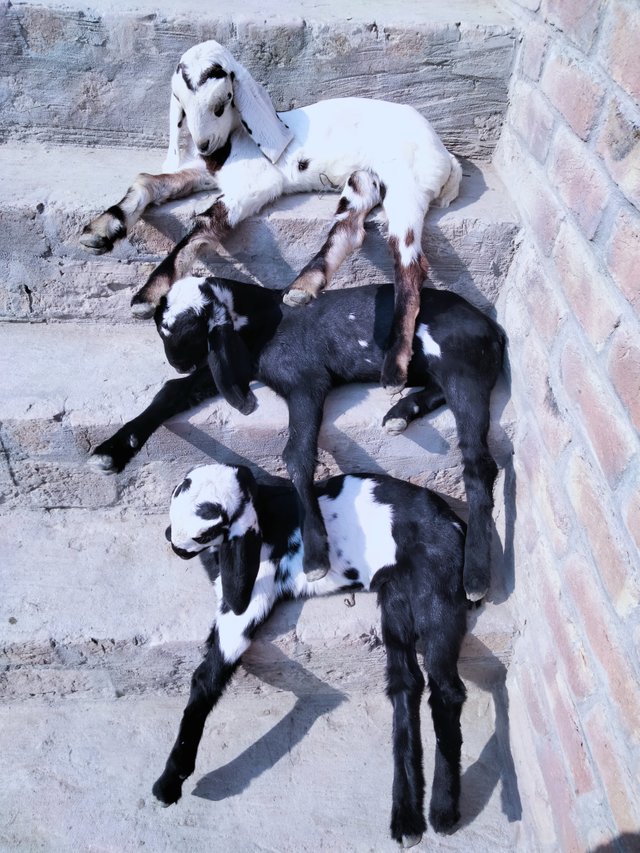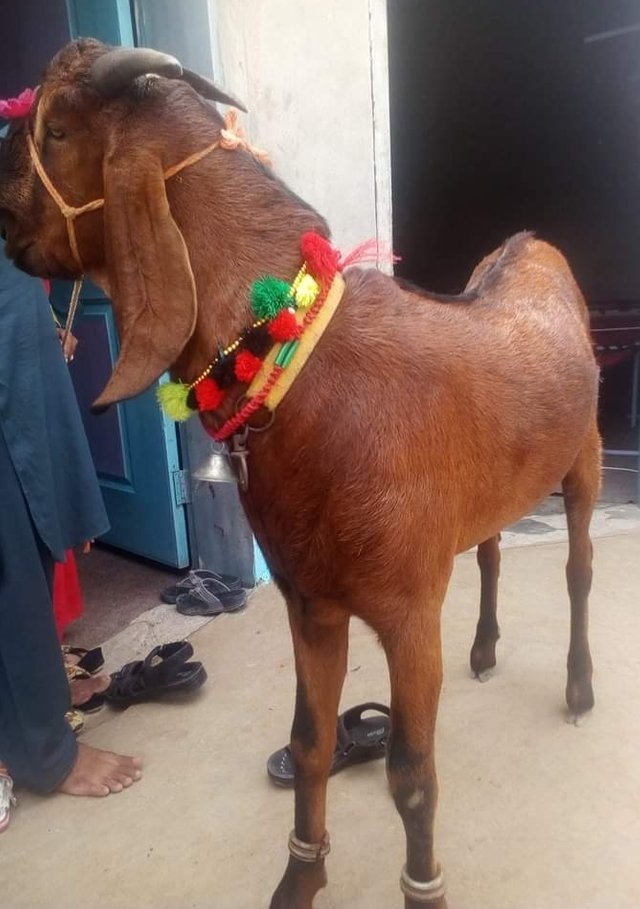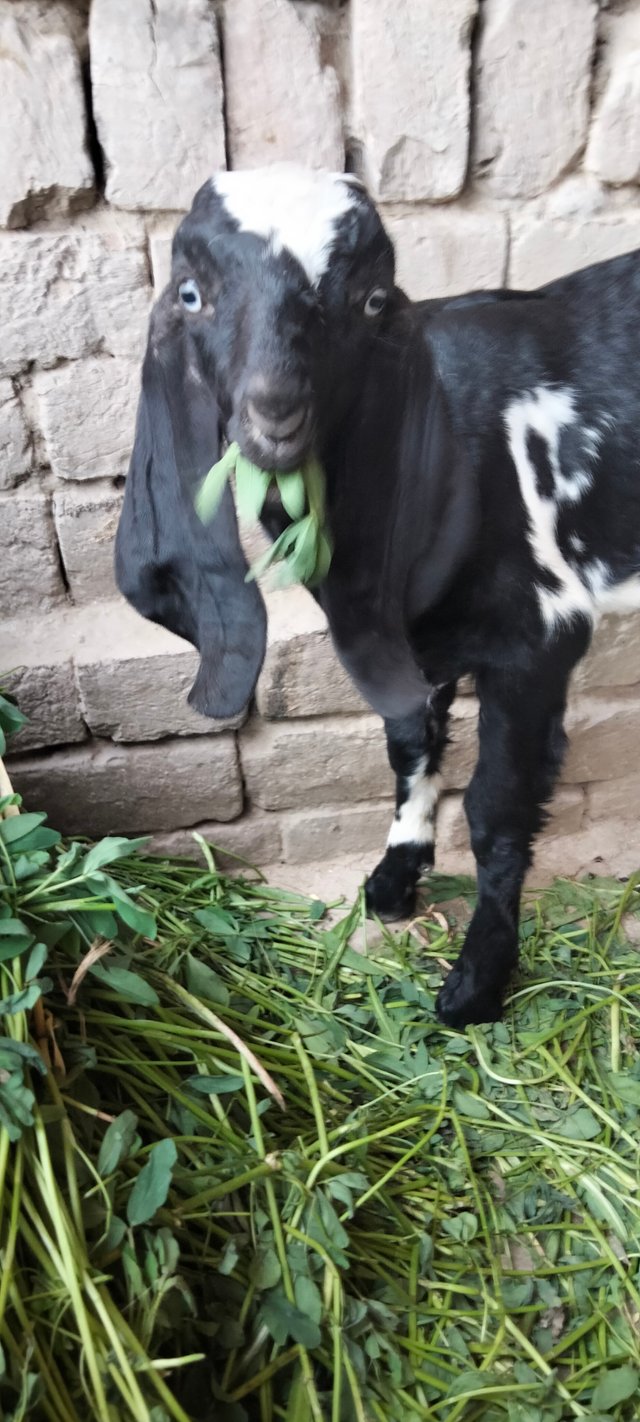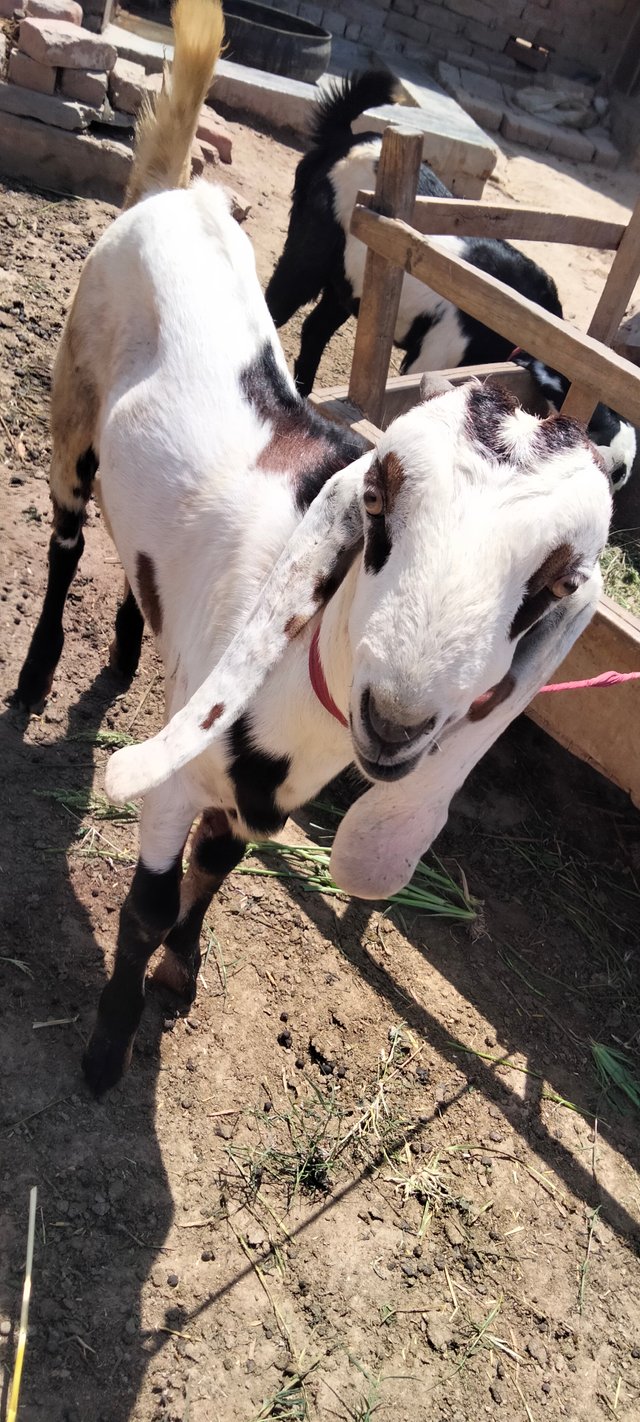
This breed of goats found in Betel Nagri Punjab is considered to be the highest in terms of weight and beauty. Dr. M. Saif-ur-Rehman, an assistant professor at the Institute of Animal Sciences, Faisalabad Agricultural University, says that beetle-like traits in indigenous goats are rarely found in any other breed. He says his best reproductive ability can be gauged from the fact that for the past several years, the animals that have been number one in heavyweight goat competitions belong to the same breed. "The goats that weighed 290 kg last year and 293 kg this year belonged to the same breed." This breed is considered suitable for milk and meat. The average weight of a beetle male is 70 to 80 kg and that of a goat is 50 to 60 kg. Dr. Saif-ur-Rehman says that other good breeds of desi goats like Makhi Cheeni, Nakri, Faisalabadi (also known as desi goat in common parlance), Betel M Nagri, Rahim Yar Khan and Gujarati etc. actually belong to Betel breed Are Betel's weight and height increase rapidly, so goats of this breed are mostly prepared for sacrifice, and because of these characteristics, they are sold at very high prices, which is why some experts call it the "goat of the rich." Also say It is mostly red with black and white spots. In animals, the dark brown or brown color is usually called red. The Barbary Book Beetle goat is strong in size, has a large head, and in some cases its nose is quite raised, which is likened to a "Roman nose". Betel breed goats are found in all canal areas of Punjab including Multan, Sahiwal, Lahore, Faisalabad, Sargodha, Jhang Okara, Jhelum, Gujranwala, Gujarat and Sialkot. Betel is said to be the closest to the Jumna goats and in some areas it is also called "Amritsar". Betel goat is also considered to be the best for milk production. With good care and food, it gives up to two and a half liters of milk per day. Dera Din Panah This breed of goat found in Dera Muzaffargarh, Layyah and Multan areas is known as Dera Din Panah area of Muzaffargarh. These black goats have large heads, while their noses are raised. In addition to the wide chubby body, the body is covered with hair and there is also hair under the chin. The neck is long and strong. Its horns are long, strong and wavy. This goat has a medium sized tail and hair. Goats of this breed give up to one and a half liters of milk per day while the average weight of males and females can be 40 to 45 kg. Dera Din Panah goats get 1200 grams of hair per person per year which is used in the manufacture of various products. This breed is found in Nachi, Nachi, Bahawalpur, Jhang, Muzaffargarh, Layyah Multan and Sahiwal areas. She is called "Nachi" because of her sweet tricks. They are usually black in color but some have white or red spots on the body. Nachi is considered to be the best breed for hair, while it is considered a medium breed in terms of meat and milk production. Their horns and ears are of medium size. One goat or goat of the Nachi breed produces 600 grams of hair annually. The average weight of an adult male and female is 33 and 28 kg, respectively. Dancing goats usually give birth to twins. Basically it is the most suitable breed for hair but it is also reared for milk and meat. In various festivals, "Nachi" attracts the attention of the people due to its unique size and gait. TD .. To be found in Dera Ismail Khan, Tank, Sargodha, Mianwali, Gujarat, Jhelum, and Rawalpindi besides adjoining areas of Azad Kashmir. This type of goat is called a "teddy" because of its short stature and compact size. In addition to white, milky, brown, black, some animals are also spotted in this breed. Small pointed horns, small ears and slightly pointed nose are some of the important symptoms. Adult males often grow a beard just below the thigh.
Teddy goats give birth twice a year, with twins having a birth rate of 50% and triplets having a birth rate of up to 15%. Adult animals of this breed usually weigh up to 30 kg on average. It is considered suitable for meat. In addition, due to the high breeding capacity, some experts believe that teddy goats can be a suitable carrier for acquiring new breeds from different breeds.
- Patiri or Patiri Patiri goats and goats of this breed found in Hyderabad, Nawabshah, Khairpur and Sanghar areas of Sindh are very beautiful. Their bodies are white and their long ears are often red or brown. Pateri is one of the fattest breeds in Sindh. The average adult male of Patiri weighs 52 kg and the female up to 42 kg. The Patiri breed is considered suitable for milk and meat production. For Eid-ul-Adha, the Patiri breed of well-bred goats has always been in demand, and because of their beauty and weight, they are able to attract the attention of buyers.

Named after the Jat tribes who raise camels in Jatan Betel Nagri Sindh, this breed is found in the Mirpur Khas District of Sindh and the deserts of Thar. They are usually yellowish brown, red and black. This large animal has long legs, while slightly longer ears often have yellowish red and black spots. Jattan goats also have a black circle around their necks. Both males and females have horns. The average weight of a goat is 50 kg and that of a goat is 42 kg. Pink. Pink goat is actually called by this name because of its beauty. Animals of this breed are considered to be the most expensive animals, the main reason for their high prices is their beauty. These white goats have long ears and a light pink color. The horns are small and medium in size. Due to their beautiful white color, traders are usually able to get the price they are asking for. * Barbary. This breed is considered suitable for milk and meat. This breed is found in Dadu, Sukkur, Nawabshah, Mirpur Khas of Sindh and Sahiwal, Lahore Jhang, Faisalabad and Sargodha areas of Punjab. The average weight of an adult male is 40 kg while that of an adult female is 25 kg. * Kamori Kamori is one of the most important breeds found in Sindh. Kamori goats are characterized by their long ears and brownish brown color. Kamori goats give birth to one to three kids at a time in a year. In addition to their tall and strong stature, this breed, which grows on the most dry and bitter foods such as cactus and camouflage, the most abundant carnivorous plant in Sindh, is known all over the world for its milk and meat. Concerns were also raised about the extinction of Kamori goats last year due to large-scale export and trafficking. According to some farmers, the number of Kamori goats in Sindh is only a few thousand. Due to its rarity, the young goats of the original Kamori breed are also being sold for Rs. 20,000 to Rs. 25,000 while the big goats are being sold for Rs. 100,000 and above. Other breeds of goats and types of bee sugar are some of the most important and well-known. In addition to breeds and species, there are many other breeds and breeds of goats in Pakistan, while there are many breeds that have not been formally identified and many breeds have different concepts due to regional names. Some of the other important breeds are: Chaparia Kohistani, Sindhi Desi, Kaghani, Khorasani, Damani, Gaddi, Lahri, Pahari, Baltistani, Bari, Biari, Buchi, Bugi Tori, Bajri, Jara Khel, Jatal, Kachhan, Ki Koti, Curry, Labri, Lohri, Lehri, Pamiri, Pothohari, Shri, Tapri or Lipi, Tharki or Thiri etc. There are many types and breeds of sheep in Pakistan. The most important breeds are Balkhi, Babarki, Danbi, Gojal, Harnai, Hashtnagri, Koh-e-Guzar, Machni, Pahari, Rakhshani, Salt Range, Terai and Wazir. Kaghani, Kail, Kelly, Koka, Lohi, Punchi, Spli and Thali are the most important types. The most famous and dear breed of sheep in terms of sacrifice is the concept of "Kajla" or Kajli. He is tall, strong, has long ears and a black mark around his eyes which makes him feel like he has mascara in his eyes and this is also the reason for this race. Apart from farming, this breed is very popular among those who are interested in raising animals for sacrifice. This can be gauged from the fact that the Kajla Umbrella Competition is held in Lahore every year, in which the owners of the winning animals are also given valuable prizes. The organizer of the competition, Ustad Javed Khusewala, says that it is well known about this generation that a pair of this umbrella was given as a gift by a foreigner to the famous Twana family of Sargodha, after which it became famous in Pakistan. When Dr. Saif-ur-Rehman of the Institute of Animal Breeding, Agricultural University, Faisalabad, says, “This is a local breed. The most obvious sign of this is that its hair is slightly stiffer which does not give a fine hair, while the hair of foreign sheep is softer. ”Kajla is taller and stronger than normal sheep. ۔ Experts say that due to its toughness, it is able to withstand various conditions and weather effects and can withstand disease and weather conditions longer than goats, which is why those who are fond of raising animals I am very popular. For many years in Lahore, the "Kajla Chhatra Show" has been held near the Saginaw Bypass. The competition is held under different categories, including nursery for young children, "Dunda", Choga, and Chagga for up to 12 months of age. There is also a category of "Kajla Kaka" in this competition. Kajla usually has black spots on the chin, eyes and ears, but "Kaka" is a kajla whose whole body is white. According to the organizers of the competition, the heaviest animal of the 2015 competition was 210 kg. Kajla prices are also very high due to its popularity. Usually its newborns are also sold for thousands of rupees, while the animals that are "sacrificed" for sacrifice are priced above one lakh. A large number of Kajla breeders raise them for sacrifice only instead of selling them. If this breed, which has the potential to meet the needs of meat and wool, is farmed on a scientific basis, many benefits can be reaped from it. * Large beef cow is primarily an animal reared for milk production. Bulls are usually the first choice for sacrifice. Cow breeds are divided into three categories, including dairy breeds, breeds used for transportation and farming, and breeds suitable for both purposes. In addition, sacrificial animals are obtained from a combination of foreign and domestic animals. Here are just a few important local breeds. Sahiwal. Sahiwal This is mainly a dairy breed and its males are used for meat production. Sahiwal is undoubtedly known all over the world. Found in the districts of Sahiwal, Okara, Pakpattan, and Faisalabad, this breed of cow has a medium to medium size. The color is reddish brown. Males are dark red and dark red on the eyes, neck and hind legs. Males have thick, strong horns, while females do not. Due to its loose skin and high male elbows, its beauty is doubled and therefore it is generally preferred for sacrifice. The Sahiwal bull weighs 400 to 500 kg while males of 1000 kg can be seen. Special care is taken for their rearing and feeding. The mountain range of Red Sindhi Sindhi Kohistan which is part of Karachi, Thatta and Dadu districts. This breed is found in the same area. Its native area extends to the fertile plains of Hyderabad and the rainfed areas of Lasbela district of Balochistan. Red Sindhi cattle are of medium height and strong size. It is usually red in color and hence it is called Red Sindhi. Bulls belonging to the Lasbela breed of this breed are slightly darker in color. Males are usually dark red on the shoulders, with a large head and a slight bulge on the forehead of some bulls. Male horns are strong and thick. The male's elbow is heavy, while the fur hanging like a fringe under the neck is between the male and the female. Animals of this breed are strong enough to withstand harsh conditions. Males weigh between 400 and 500 kg while females weigh up to 350 kg. Cholistani: This breed belongs to the desert area of Cholistani Cholistan in different areas of Bahawalpur, Bahawalnagar and Rahim Yar Khan. Is found. Cattle of this breed are of loose shape and have short horns and long ears. The male's elbow is heavy and the fur hangs like a fringe under the neck. There are brown, red and black spots on the white body color. The average weight of a male is four hundred and fifty to five hundred kilograms. Cholistani oxen are also used for transportation and farming, while in both cases it is considered a good source of meat due to the increasing use of machinery. Due to its heavy size and elbow, this bull remains the center of attention of buyers for sacrifice. According to Bhag Nadi experts, Bhag Nadi is naturally the heaviest breed in Pakistan. Bulls of this breed are commonly called "Sibi Bull" or Sibbi Bulls in the market. Adult males are up to six feet tall. The Bhag-Nari is primarily a breed suitable for transportation and farming, but due to its tall stature and heavy size, this breed of beautiful bull is considered to be the first choice of buyers for sacrifice. Found in the hottest areas of Balochistan, this breed is very hardy and has the ability to withstand famine. Other breeds besides these well-known breeds are Dajjal, Dhani, Lohani, Rojhan, Thar Parkar and Hisari local breeds. There are also animals whose animals are brought to the markets for sacrifice. Mixed breeds of large animals are also raised for milk and meat and mixed breeds are also brought to the markets for sacrifice. Foreign breeds of Friesian and Jersey are usually crossed with Red Sindhi and Sahiwal. The bulls of the Friesian and Australian breeds are very heavy, but because of their traditional sun-drenches, the local breeds are preferred for sacrifice. Camels as a whole are rarely sacrificed. People living in plains and urban areas are not accustomed to eating its meat, which is why only those who have certain tastes sacrifice this animal on Eid-ul-Adha. Many species of camels are found in the desert areas of Balochistan, Sindh and Punjab including Cholistan, Barela, Brahui, Kachhi, Kharani, Lasi, Makrani, Pashni, Rudbari, Maya, Bagri, Kala Chitta, Moricha, Lari, Sakrai and others. Are For the past several years, experts have been expressing concerns about the declining number of camels in Pakistan. According to a report published in 2010, Pakistani camel breeds are in danger of extinction due to neglect of camel breeding, smuggling and famine in the Gulf countries. According to an estimate, about 30,000 camels are sacrificed every year across the country. Cheap Sacrifice One by one, the practice of collective sacrifice is becoming more and more common. On the occasion of Eid-ul-Adha, the prices of all animals, big and small, start skyrocketing. In particular, the average price of goats reaches 15 to 20 thousand and the goat found in this price would be a "goat" only legally, otherwise the buyers still do not understand what to call it in terms of weight and height. It is estimated that more than four million goats and more than one million sheep are sacrificed on Eid-ul-Adha in Pakistan every year. Dr. Saif-ur-Rehman, an assistant professor at the Institute of Animal Sciences at the University of Agriculture, Faisalabad, says that some breeds of goats, such as betel, kajla, etc., are usually very expensive. Their good physique and stature are also the main reason for their high price. "Every year millions of people in our country have to perform the Sunnah of Abraham. For this, if the middle-class breeds are bred in an orderly manner, the number of sacrificers may also increase, as even middle-income people are generally unable to sacrifice due to the high cost of animals. ” It is also worth mentioning that in the vast cattle markets in the big cities, the government collects taxes and rents in different periods, but no mechanism is set up to control the prices. Dr. Mohsin Niaz, a researcher on livestock in Pakistan, also says that traders usually buy animals from remote areas of the country at very low prices and sell them at high prices in cities. As a result, livestock keepers do not get the real benefit of this economic activity.

If there is a plan at the government level for the sale and purchase of animals and for systematic farming and breeding, then the prices of sacrificial animals will go up.

I hope you like my post.
nice pet lovers
Downvoting a post can decrease pending rewards and make it less visible. Common reasons:
Submit
Wha
Downvoting a post can decrease pending rewards and make it less visible. Common reasons:
Submit